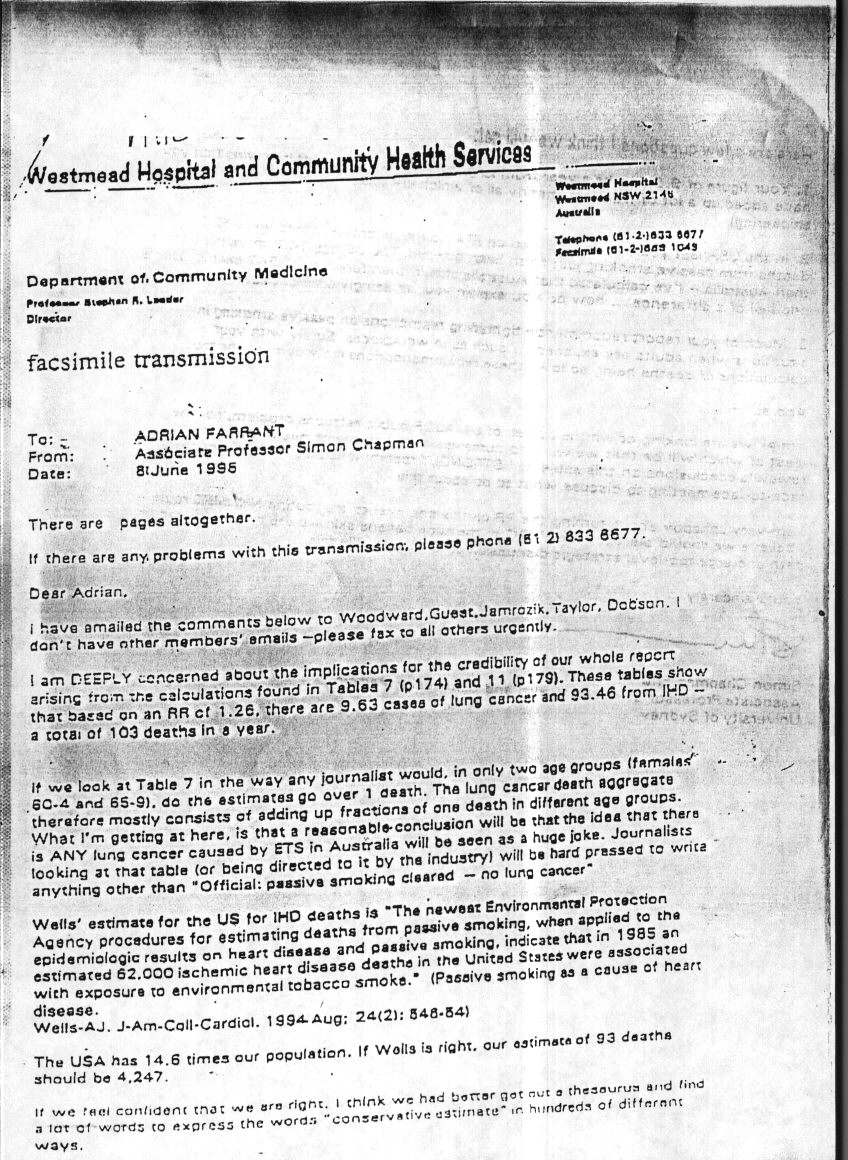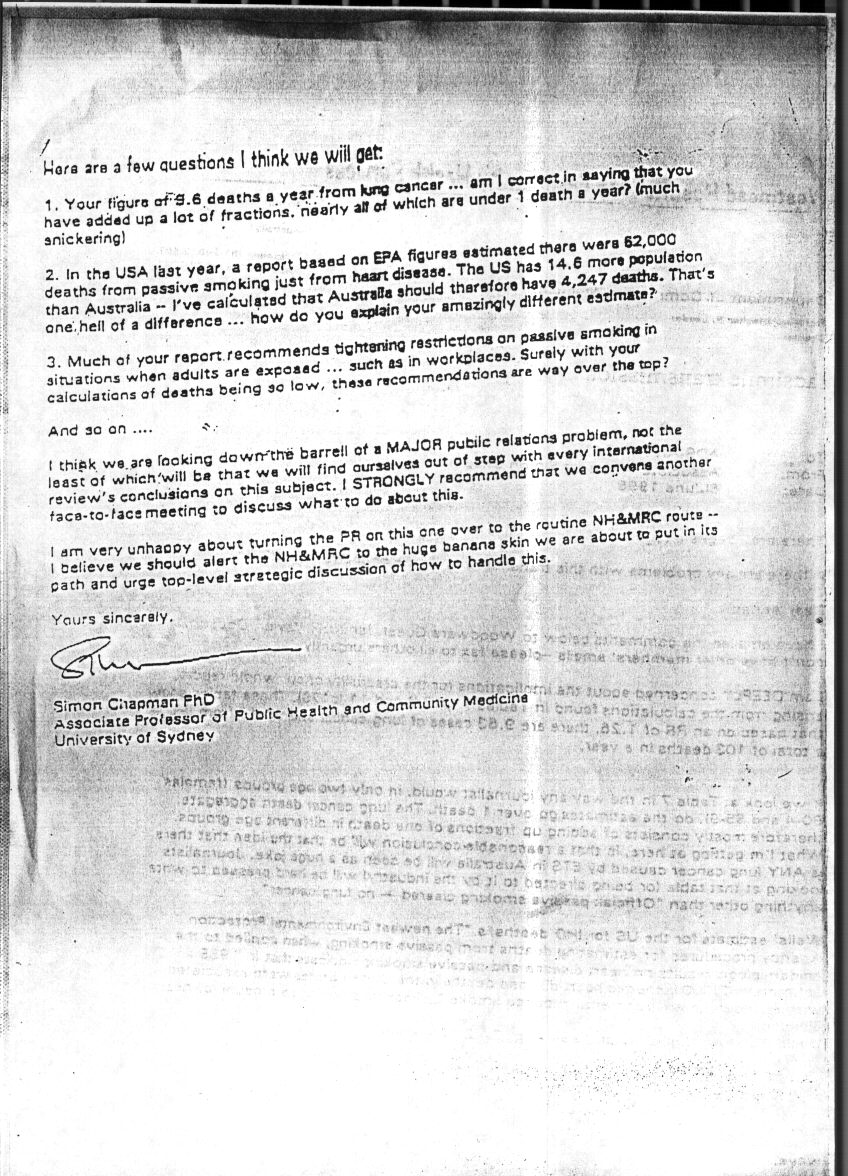Difference between revisions of "Simon Chapman 1995 fax"
Paul Herring (talk | contribs) (Created page with "This is a transcript of the fax sent in 1995 sent by Simon Chapman to Adrian Farrant a the Westmead Hospital and Community Health Services, encouraging them to manipulate ...") |
Paul Herring (talk | contribs) |
||
| Line 2: | Line 2: | ||
==Transcription== | ==Transcription== | ||
| − | See below for the actual scans. | + | See [[#Scan_of_Fax|below]] for the actual scans. |
<span style="text-decoration: underline;">'''Westmead Hospital and Community Health Services'''</span> | <span style="text-decoration: underline;">'''Westmead Hospital and Community Health Services'''</span> | ||
| Line 37: | Line 37: | ||
I am DEEPLY concerned about the implications for the credibility of our whole report arising from the calculations found in Tables 7 (p174) and 11 (p179). These tables show that based on an RR of 1.26, there are 9.63 cases of lung cancer and 93.46 from IHD - a total of 103 deaths a year. | I am DEEPLY concerned about the implications for the credibility of our whole report arising from the calculations found in Tables 7 (p174) and 11 (p179). These tables show that based on an RR of 1.26, there are 9.63 cases of lung cancer and 93.46 from IHD - a total of 103 deaths a year. | ||
| − | If we look at Table 7 in the way any journalist would, in only two age groups (females 60-4 and 65-9), do the estimates go over 1 death. The lung cancer death aggregate therefore mostly consists of adding up fractions of one death in different age groups. What I'm getting at here, is that a reasonable conclusion will be the idea that there is ANY lung cancer caused by [[ETS]] in Australia will be seen as a huge joke. Journalists looking at that table (or being directed to it by the industry) will be hard pressed to write anything other than "Official: passive smoking cleared - no lung cancer" | + | If we look at Table 7 in the way any journalist would, in only two age groups (females 60-4 and 65-9), do the estimates go over 1 death. The lung cancer death aggregate therefore mostly consists of adding up fractions of one death in different age groups. What I'm getting at here, is that a reasonable conclusion will be the idea that there is ANY lung cancer caused by [[ETS]] in Australia will be seen as a huge joke. Journalists looking at that table (or being directed to it by the industry) will be hard pressed to write anything other than "Official: [[passive smoking]] cleared - no lung cancer" |
| − | Walls' estimate for the US for [[IHD]] deaths is "The newest Environmental Protection Agency procedures for estimating deaths from [[ | + | Walls' estimate for the US for [[IHD]] deaths is "The newest Environmental Protection Agency procedures for estimating deaths from [[passive smoking]], when applied to the epidemioligic[sic] results on heart disease and [[passive smoking]], indicate that in 1985 an estimated 62,000 ischemic heart disease deaths in the United States were associated with exposure to environmental tobacco smoke." ([[Passive smoking]] as a cause of heart disease. |
Wells-AJ, J-Am-Coll-Cardiol. 1994-Aug:24(2):24654) | Wells-AJ, J-Am-Coll-Cardiol. 1994-Aug:24(2):24654) | ||
| Line 50: | Line 50: | ||
1. Your figure of 9.6 deaths a year from lung cancer ... am I correct in saying you have added up a lot of fractions, nearly all of which are under 1 death a year? (much snickering) | 1. Your figure of 9.6 deaths a year from lung cancer ... am I correct in saying you have added up a lot of fractions, nearly all of which are under 1 death a year? (much snickering) | ||
| − | 2. In the USA last year, a report based on EPA figures estimated there were 62,000 deaths from [[ | + | 2. In the USA last year, a report based on EPA figures estimated there were 62,000 deaths from [[passive smoking]] just from heart disease. The US has 14.6 more population than Australia -- I've calculated that Australia should therefore have 4,247 deaths. That's one hell of a difference... how do you explain your amazingly different estimate? |
| − | 3. Much of your report recommends tightening restrictions on passive smoking in situations where adults are exposed ... such as in workplaces. Surely with your calculations of deaths being so low, these recommendations are way over the top? | + | 3. Much of your report recommends tightening restrictions on [[passive smoking]] in situations where adults are exposed ... such as in workplaces. Surely with your calculations of deaths being so low, these recommendations are way over the top? |
And so on ... | And so on ... | ||
Revision as of 09:28, 25 July 2012
This is a transcript of the fax sent in 1995 sent by Simon Chapman to Adrian Farrant a the Westmead Hospital and Community Health Services, encouraging them to manipulate their figures because their research showed that SHS didn't increase the risk of lung cancer sufficiently to scare the general public.
Transcription
See below for the actual scans.
Westmead Hospital and Community Health Services
Department of Community Medicine
Processor Stephen R Leeder
Director
facsimile transmission
To: ADRIAN FARRANT
From: Associate Professor Simon Chapman
Date: 8th June 1995
There are pages altogether.
If there are any problems with this transmission, please phone (51.2) 833 8677
Dear Adrian
I have emailed the comments below to Woodward, Guest, Jamrozik, Taylor, Dobson. I don't have other members' emails - please fax to all others urgently.
I am DEEPLY concerned about the implications for the credibility of our whole report arising from the calculations found in Tables 7 (p174) and 11 (p179). These tables show that based on an RR of 1.26, there are 9.63 cases of lung cancer and 93.46 from IHD - a total of 103 deaths a year.
If we look at Table 7 in the way any journalist would, in only two age groups (females 60-4 and 65-9), do the estimates go over 1 death. The lung cancer death aggregate therefore mostly consists of adding up fractions of one death in different age groups. What I'm getting at here, is that a reasonable conclusion will be the idea that there is ANY lung cancer caused by ETS in Australia will be seen as a huge joke. Journalists looking at that table (or being directed to it by the industry) will be hard pressed to write anything other than "Official: passive smoking cleared - no lung cancer"
Walls' estimate for the US for IHD deaths is "The newest Environmental Protection Agency procedures for estimating deaths from passive smoking, when applied to the epidemioligic[sic] results on heart disease and passive smoking, indicate that in 1985 an estimated 62,000 ischemic heart disease deaths in the United States were associated with exposure to environmental tobacco smoke." (Passive smoking as a cause of heart disease. Wells-AJ, J-Am-Coll-Cardiol. 1994-Aug:24(2):24654)
The USA has 14.6 times our population. If Walls is right, our estimates of 93 deaths should be 4,247.
If we feel confident that we are right, I think we had better get out a thesaurus and find a lot of words to express the words "conservative estimate" in hundreds of different ways.
Here are a few questions I think we will get:
1. Your figure of 9.6 deaths a year from lung cancer ... am I correct in saying you have added up a lot of fractions, nearly all of which are under 1 death a year? (much snickering)
2. In the USA last year, a report based on EPA figures estimated there were 62,000 deaths from passive smoking just from heart disease. The US has 14.6 more population than Australia -- I've calculated that Australia should therefore have 4,247 deaths. That's one hell of a difference... how do you explain your amazingly different estimate?
3. Much of your report recommends tightening restrictions on passive smoking in situations where adults are exposed ... such as in workplaces. Surely with your calculations of deaths being so low, these recommendations are way over the top?
And so on ...
I think we are looking down the barrell[sic] of a MAJOR public relations problem, not the least of which will be that we will find ourselves out of step with every international review's conclusions on this subject. I STRONGLY recommend that we convene another face-to-face meeting to discuss what to do about this.
I am very unhappy about turning the PR on this one over to the routine NH&MRC route -- I believe we should alert the NH&MRC to the huge banana skin we are about to put in its path and urge top-level strategic discussion of how to handle this.
Yours Sincerely
[signature]
Simon Chapman PhD
Associate Professor of Public Health and Community Medicine
Scan of Fax
Page 1
Page 2

